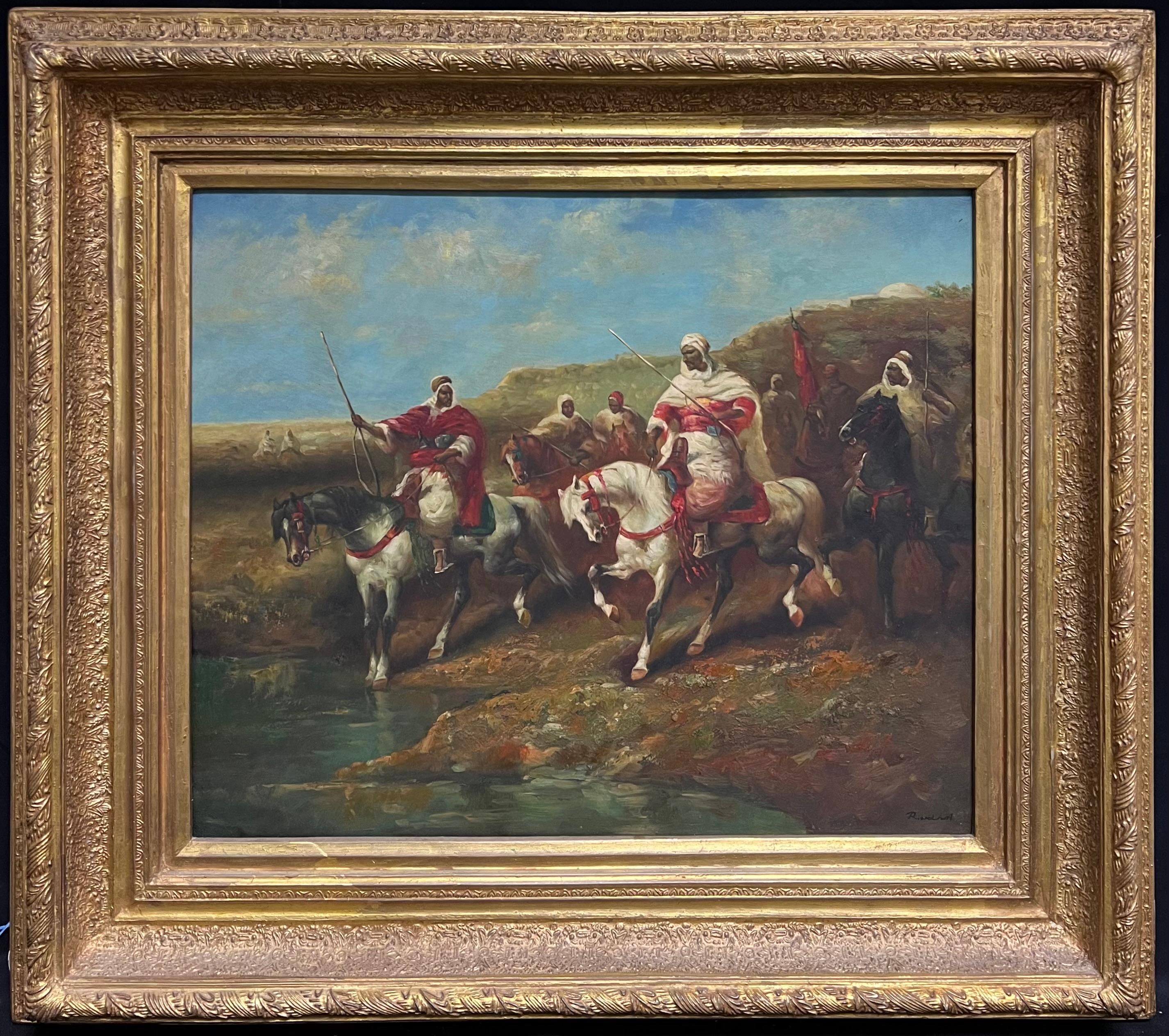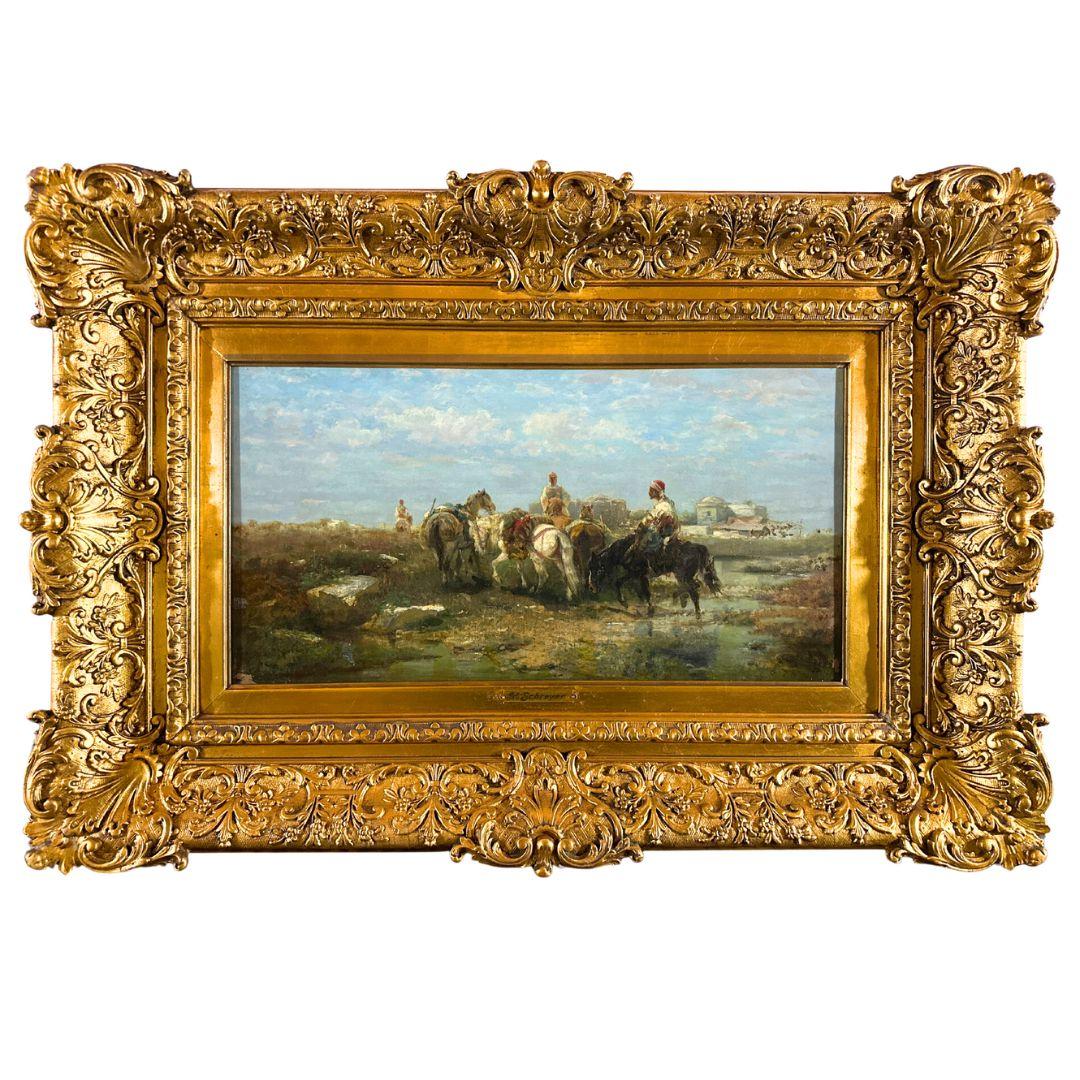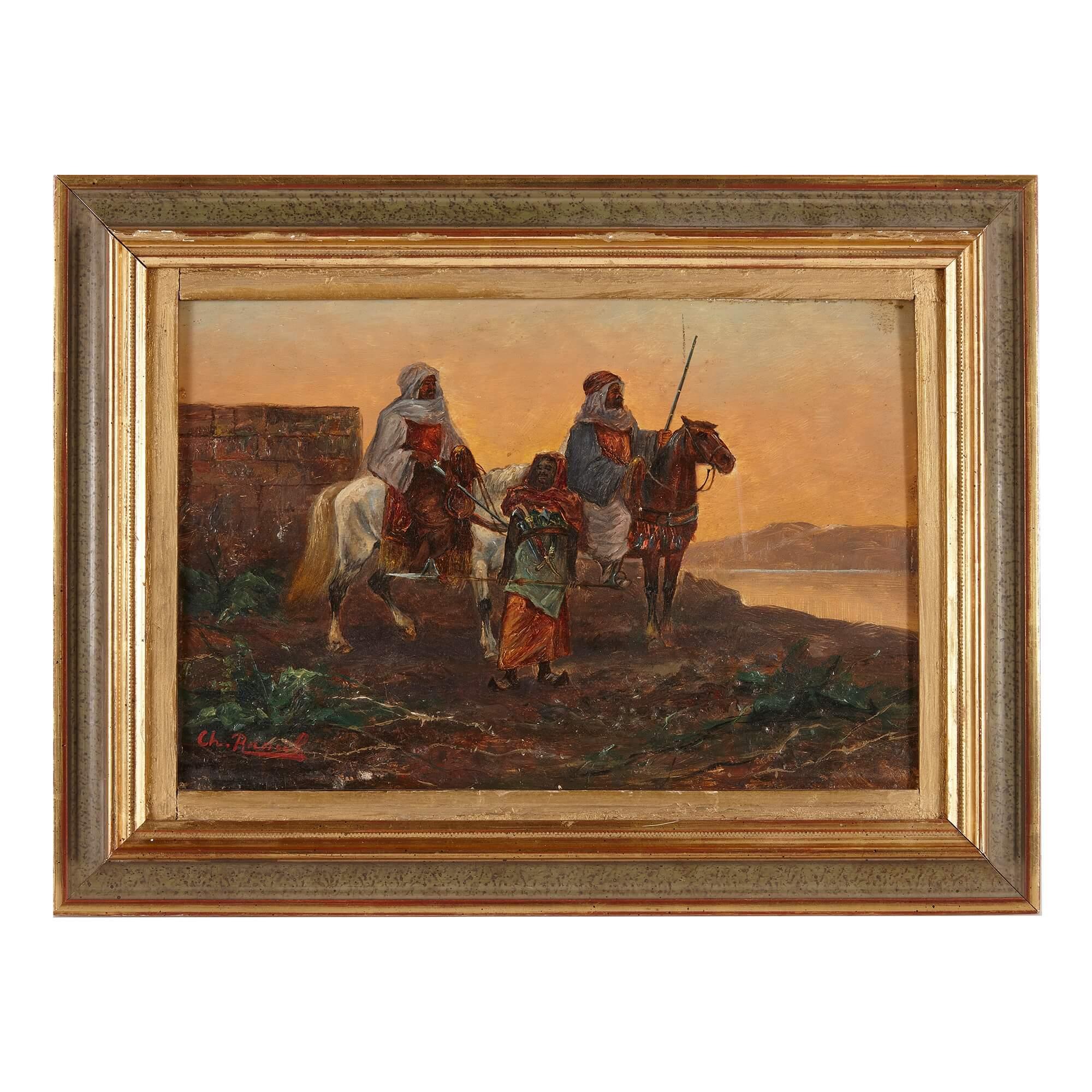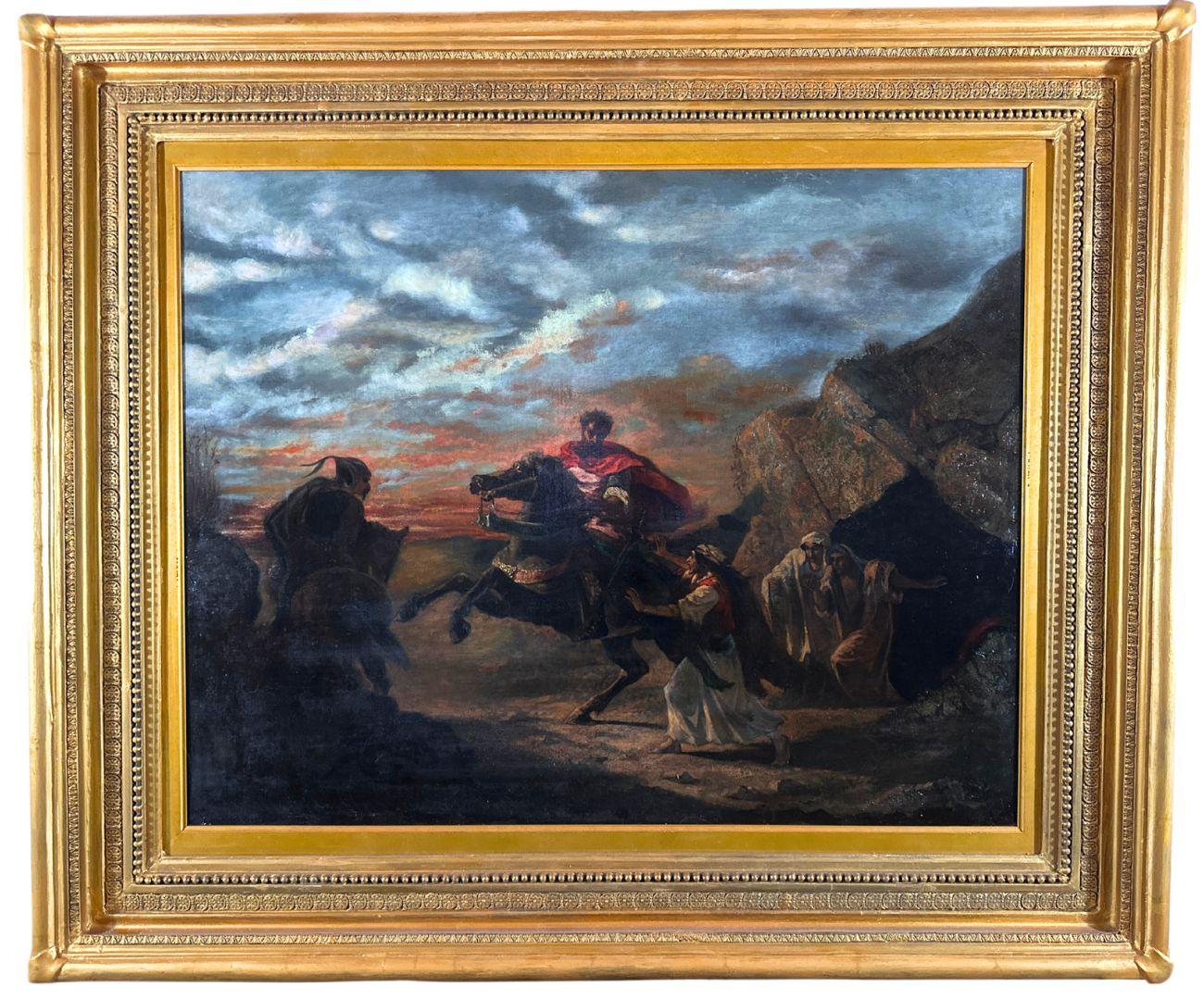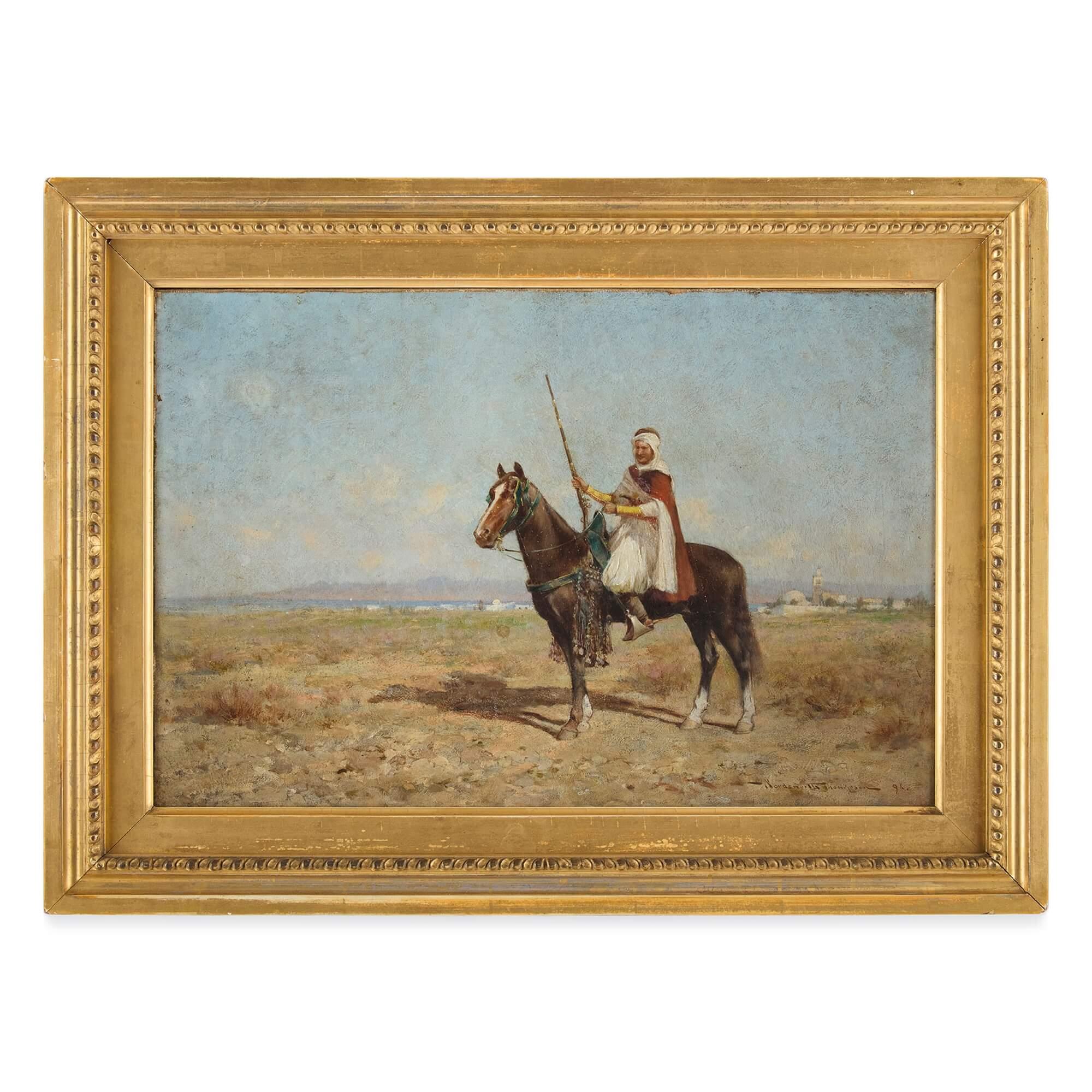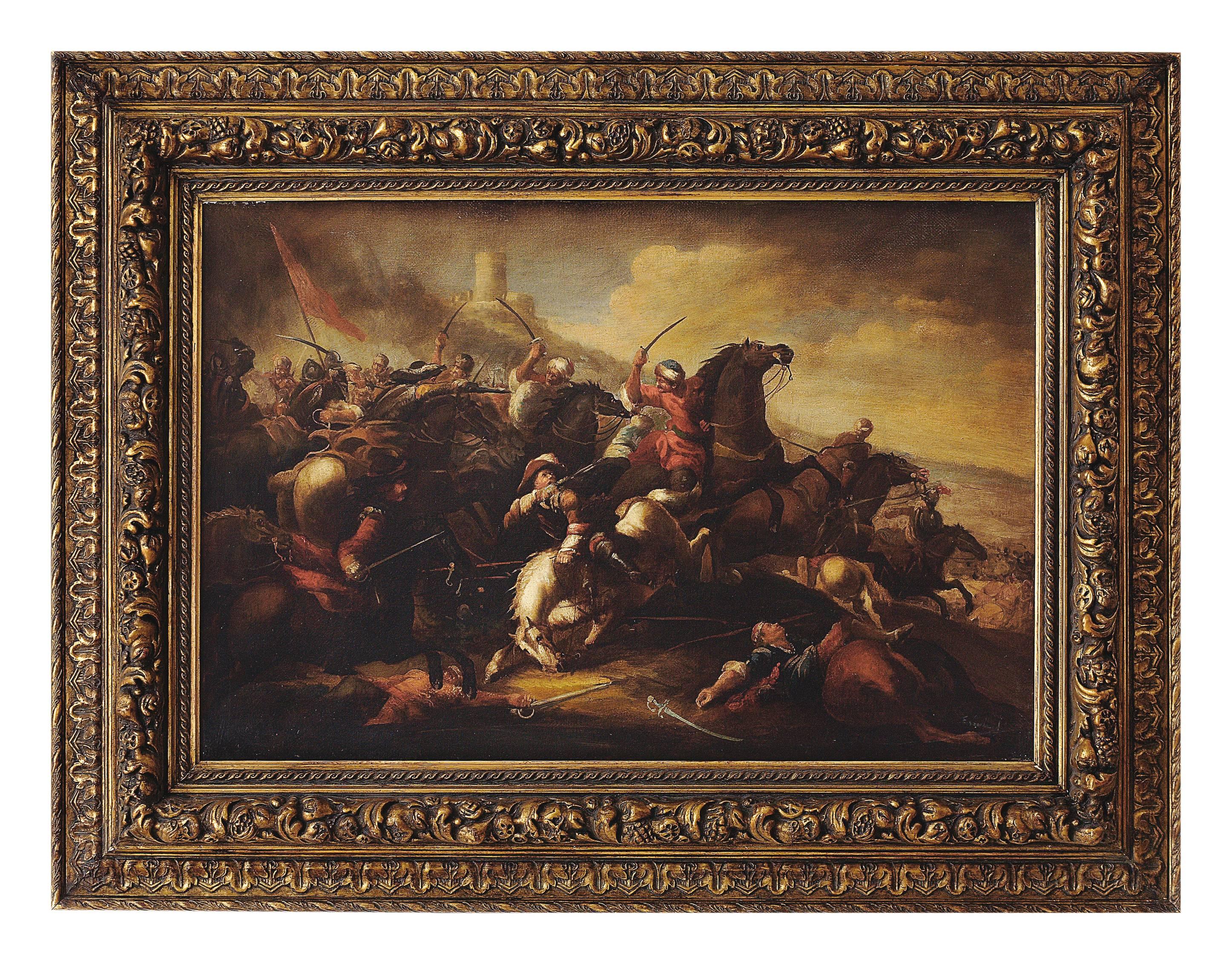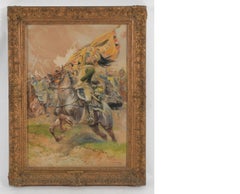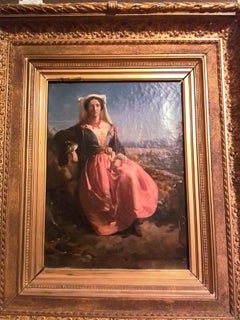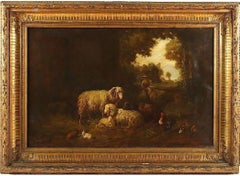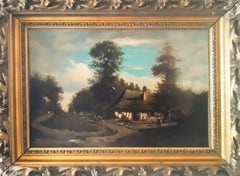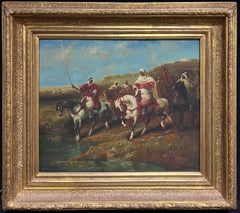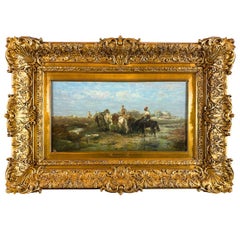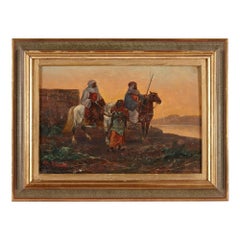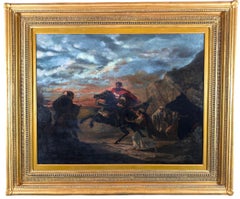Items Similar to Orientalist cavalry scene Decamps Gabriel - oil on canvas - initials DC
Want more images or videos?
Request additional images or videos from the seller
1 of 22
Orientalist cavalry scene Decamps Gabriel - oil on canvas - initials DC1803-1860
1803-1860
$8,616.26
£6,400.44
€7,200
CA$11,886.73
A$13,066.79
CHF 6,867.31
MX$158,678.43
NOK 85,667.91
SEK 81,164.32
DKK 54,810.13
About the Item
Conditions : Excellent overall Condition.
Great Master of Orientalism:
Decamps revealed Orientalism at the 1831 Salon, establishing himself as an essential reference. The 1831 Salon marked a turning point in the history of Orientalism. For the first time, the public discovered the everyday Orient through sincere, realistic works inspired by a painter's travels. Decamps' works, especially "The Turkish Patrol", with its subjects and strong contrasts of light and shadow, immediately established him as the leading figure in Orientalism for years to come. Henri Focillon observed, "These delightful images of a world that Romanticism had glimpsed through the splendors of the "Itinerary" are now powerfully entrenched in French painting by Decamps' forceful style. From now on, the Orient will be one of the lasting fascinations of our masters."
Théophile Gautier compared Decamps' role as a discoverer of the Orient to that of Jean-Jacques Rousseau, who "discovered" nature: "In the nineteenth century, Mr. Decamps discovered the Orient. One could say that before him, these sun-drenched lands hardly existed in art."
Maxime Du Camp acknowledged Decamps' considerable influence on painters, likening him to a "Christopher Columbus of the Orient." His influence was evident in works like Delacroix's "Convulsionists of Tangier", and is also reflected in the works of Fromentin, Gérôme, and most Orientalist artists.
"Despite the abundance of exotic art, Decamps’ work remained the definitive reference until quite late," wrote Christine Peltre. "It was the most accessible and matched the popularity of "One Thousand and One Nights". This impression was not limited to painters." Indeed, when Le Corbusier first encountered the Orient in Constantinople, Decamps' example immediately came to mind.
Decamps Returns the Bible to the Orient
Historically, biblical scenes were often set in nearby European landscapes: Tuscan scenes for Florentine paintings, and northern landscapes for Flemish and Dutch art. With classicism, Italian scenery became the ideal, even when stylized. The Holy Land was paradoxically separated from the Orient, then unknown to painters.
As the acknowledged founder of Orientalism, Decamps returned the Bible to the Orient. He balanced two ambitions: being recognized as a history painter while gaining widespread admiration as an Orientalist. His religious works were set in severe, majestic Eastern landscapes, often bathed in light: "Joseph Sold by His Brothers" (1839 Salon), "Samson Fighting the Philistines" (1839 Salon), "Joshua Stopping the Sun", "The Story of Samson" (1845 Salon), "Eliezer and Rebecca" (1850-51 Salon), and "Saul Pursuing David".
Decamps avoided the anecdotal elements typical of Orientalism, aware that they were inappropriate for religious art. His landscapes were believable yet stylized and powerful, with figures often small and placed in the background. What mattered most was the sense of evocation, transporting the viewer to a captivating biblical Orient.
Bruno Foucart highlighted Decamps' pivotal role in the renewal of religious painting. Following Ingres, who inherited Raphael’s legacy, and Delacroix, heir to Veronese, Decamps, as Rembrandt’s heir, opened a third path in religious painting, the boldest and most innovative of his time. "In this context, Decamps is truly the founding father of Orientalism; he immediately demonstrates the limited value of exact exotic descriptions, relying instead on impression; he sets the limits of a new historical painting that is more evocative than descriptive."
Decamps infused landscapes with a spiritual quality, removing unnecessary descriptive elements, sometimes approaching abstraction. What remains is the Orientalist emotion and a sense of the sacred.
A Pioneer of Realism
"Decamps loved life in its most familiar aspects, enjoying landscapes, animals, and the lives of humble people [...] In this way, he continued Géricault’s work and foreshadowed Millet’s."
"The generation of artists between 1830 and 1840 was filled with those striving to free themselves from the literary and historical influences of Romanticism and the academicism of classical artists, seeking to depict the contemporary life of humanity. This desire to return art to its true path, to make it express the forms and aspirations of the modern world, can be felt from the beginning of the century. But even without referencing Delacroix, Géricault, Gros, or David, it is clear that Decamps, and those following him, embodied a wave of artists deeply moved by the fermenting ideas of that period, culminating in the democratic upheavals of 1848," analyzed Léonce Bénédite.
A Major Figure of His Time
Henri Gervex, 1889, Petit Palais, Paris.
Adolphe Moreau (1800-1859), private collector and friend of Decamps’ brother Maurice-Alexandre, created a systematic catalog of Decamps’ work during the artist’s lifetime. It included original prints, reproductions of all kinds—paintings, watercolors, pencil and charcoal drawings, twenty etchings and crayon works, hundreds of lithographs, and wood engravings. Eugène Prosper Leroux, a contemporary, successfully reproduced Decamps’ works in lithographic form.
Though he did not always win the favor of exhibition juries, Decamps was well-received by the public. His genre scenes were especially popular commercially. He maintained strong relationships with private collectors, art lovers, and merchants who admired his work and dealt directly with him, such as the English watercolorist Arrowsmith. His patrons included the Duke of Orleans. Most sketches had pre-determined buyers, and his public sales were always highly anticipated events that excited his fans. However, despite receiving most honors and recognition available to artists, Decamps received only one official commission, "Job and His Friends", which he was unable to complete due to health issues.
SHIPPING: Continental USA and Worldwide delivery included
- Attributed to:Decamps Gabriel Alexandre (1803 - 1860, French)
- Creation Year:1803-1860
- Dimensions:Height: 11.02 in (28 cm)Width: 18.89 in (47.99 cm)
- More Editions & Sizes:11.02 x 18.89Price: $8,616
- Medium:
- Movement & Style:
- Period:
- Condition:
- Gallery Location:PARIS, FR
- Reference Number:1stDibs: LU2804215381112
About the Seller
5.0
Vetted Professional Seller
Every seller passes strict standards for authenticity and reliability
Established in 2024
1stDibs seller since 2024
10 sales on 1stDibs
- ShippingRetrieving quote...Shipping from: PARIS, France
- Return Policy
Authenticity Guarantee
In the unlikely event there’s an issue with an item’s authenticity, contact us within 1 year for a full refund. DetailsMoney-Back Guarantee
If your item is not as described, is damaged in transit, or does not arrive, contact us within 7 days for a full refund. Details24-Hour Cancellation
You have a 24-hour grace period in which to reconsider your purchase, with no questions asked.Vetted Professional Sellers
Our world-class sellers must adhere to strict standards for service and quality, maintaining the integrity of our listings.Price-Match Guarantee
If you find that a seller listed the same item for a lower price elsewhere, we’ll match it.Trusted Global Delivery
Our best-in-class carrier network provides specialized shipping options worldwide, including custom delivery.More From This Seller
View AllCavalry Charge 1st Empire - Edouard Detaille - French art
By Jean Baptiste Édouard Detaille
Located in PARIS, FR
Conditions : Very good original Conditions including a beautiful frame. Framed under glass, this rare composition for sale is an exceptionnel piece for Art collectors.
Signed and d...
Category
Late 19th Century Academic Landscape Paintings
Materials
Tempera
LePoittevin Eugene - Italianate Landscape with a woman - oil on canvas - signed
Located in PARIS, FR
Conditions : Very good overall conditions, original canvas with no minor retouching, except on the dress 12mm ( as seen on picture under UV light). The signature is dated 1852 or 53....
Category
Mid-19th Century Realist Landscape Paintings
Materials
Oil
Antique art painting with sheeps in a barn
Located in PARIS, FR
Conditions: In excellent overall conditions, with no repaint under UV light, original canvas and frame. Signed Lower left "Ls Reinhardt". Dimensions with the frame are approximately...
Category
Late 19th Century Impressionist Landscape Paintings
Materials
Oil
Vintage french art by Louis Cabat - cottage in Normandy - oil on canvas, signed.
Located in PARIS, FR
A certificate of authenticity from Mr. Michel Rodrigue accompanies the work.
Conditions : Good overall Conditions. Older restauration in the upper part under UV light. Canvas relined...
Category
Early 19th Century Realist Landscape Paintings
Materials
Oil
Vintage french art painting by Paul emile Lecomte - oil on canvas, signed
By Paul Emile Lecomte
Located in PARIS, FR
Old exhibition label. Free US CONTINENTAL Shipping, incl Europe and Asia.
Provenance: Artist's family, atelier sale. Excellent condition under UV light with no prior restoration. T...
Category
Late 19th Century Impressionist Landscape Paintings
Materials
Oil
Animal Scene, oil on wood, signed lower left
Located in PARIS, FR
Conditions : Excellent, original period frame.
Louis Coignard, (September 4, 1812, Mayenne - November 20, 1880, Paris), French painter. He was the son of Élisabeth Sigoigne, younges...
Category
Late 19th Century Realist Landscape Paintings
Materials
Oil
You May Also Like
North African French Orientalist Signed Oil Painting Figures on Horseback Swords
Located in Cirencester, Gloucestershire
French Orientalist Schooll
late 20th century
signed oil painting on canvas, framed
framed: 30 x 34 inches
canvas: 20 x 24 inches
Provenance: private collection, Cornwall, England
Con...
Category
20th Century French School Figurative Paintings
Materials
Oil
Arab Horsemen 19th Century Antique Landscape orientalist Oil Painting on Canvas
By Adolf Schreyer
Located in Jacksonville, FL
Notes: This painting was reviewed via digital photographs by Max and Dr. Christoph Andreas who confirmed it authenticity. They commented that the painting
would benefit from removal of the discolored varnish.
Provenance:
Provenance: Christie's New York, 19th Century European Paintings, Drawings, Watercolors, and Sculpture, February 23, 1989, Lot 125.
Private Collection, Boston MA, Skinner Auction, Nov 2021
Arab Horsemen" by Adolf Schreyer captures the grace and power of Arab horsemen in a vibrant Middle Eastern setting. Schreyer, a renowned artist of the 19th century, adeptly portrays equestrian scenes with exceptional skill and detail. The painting showcases a group of horsemen galloping through a desert landscape, evoking a sense of freedom and adventure. Schreyer's meticulous attention to detail brings the scene to life, with sunlight reflecting off the horses' coats and dust rising beneath their hooves. Beyond its visual appeal, the artwork holds cultural significance, bridging the gap between cultures and inviting appreciation of Arabian heritage. Schreyer's experiences in North Africa, Turkey, and Syria inform his captivating depictions. "Arab Horsemen" is highly regarded in both America and France, where Schreyer's works found admiration among collectors and his association with the Barbizon School solidified his reputation. Owning this artwork not only adds beauty but also connects to a pivotal period in art history, showcasing Schreyer's artistic brilliance and cross-cultural appreciation. Experience the timeless allure of "Arab Horsemen" and embrace the spirit of the Middle East.
Frame Size: Width: 36″ x Hight: 24.75″
Frame Thickness: 6.50″
Picture Size: Width: 24″ x 12.75″
Description:
Introducing “Arab Horsemen” by Adolf Schreyer: A Captivating Blend of Artistry and Cultural Significance
Capture the essence of the vibrant Middle Eastern culture with “Arab Horsemen,” a masterpiece by the renowned artist Adolf Schreyer. This captivating painting takes you on a journey through time, allowing you to witness the grace, power, and elegance of Arab horsemen in their natural element.
Adolf Schreyer, a celebrated artist of the 19th century, gained immense popularity and admiration for his exceptional ability to depict equestrian scenes with unparalleled skill and detail. Born in Frankfurt, Germany in 1828, Schreyer developed a profound fascination for the Orientalist movement, which celebrated the exoticism and allure of the Middle East.
“Arab Horsemen” exemplifies Schreyer’s signature style, highlighting his mastery of capturing the energy and spirit of his subjects. The painting portrays a group of Arab horsemen galloping across a vast desert landscape, their silhouettes evoking a sense of freedom and adventure. Schreyer’s meticulous attention to detail is evident in every brushstroke, as he adeptly captures the shimmering sunlight bouncing off the horses’ coats and the billowing dust beneath their hooves.
What sets Schreyer apart is his ability to transcend mere representation and infuse his artworks with a profound cultural significance. His depictions of Arab horsemen are not only visually stunning but also serve as a bridge between cultures, inviting viewers to explore and appreciate the richness of Arabian heritage. The artist’s fascination with the Middle East stems from his experiences traveling through North Africa, Turkey, and Syria, immersing himself in the sights, sounds, and traditions of these enchanting lands.
“Arab Horsemen” holds a special place in the hearts of art enthusiasts in both America and France. Schreyer’s works found great admiration and recognition in these countries during his lifetime and continue to captivate audiences to this day. In America, his paintings were sought after by collectors who were drawn to the romanticism and exoticism of the Orient. In France, Schreyer’s association with the Barbizon School, a group of artists who favored realistic depictions of rural life, further solidified his reputation as a respected painter.
Owning a piece by Adolf Schreyer, especially “Arab Horsemen,” is not merely acquiring a beautiful artwork but also an opportunity to possess a tangible link to a pivotal period in art history. Schreyer’s ability to seamlessly blend artistic brilliance with cross-cultural appreciation makes this painting an invaluable addition to any collection. Experience the timeless allure of “Arab Horsemen” and let the spirit of the Middle East gallop into your life.
Collections holding paintings by Adolf Schreyer include the
Collections:
Schwerin Gallery
Count Mensdorff-Pouilly Collection
Raven Gallery, Berlin
Rockefeller Family Collection
Vanderbilt Family Collection
John Jacob Astor Collection
William Backhouse Astor, Sr. Collection
August Belmont Collection
William Walters Collection...
Category
19th Century Academic Landscape Paintings
Materials
Canvas, Oil
Orientalist Oil Painting with Equestrian Subject
Located in London, GB
Orientalist oil painting with Equestrian subject
Continental, Early 20th century
Canvas size: Height 21cm, width 32cm
Framed size: Height 30cm, width 40cm, depth 3cm
Drawing upon a ...
Category
Early 20th Century Figurative Paintings
Materials
Oil, Panel
Kidnapped by the Raiders By French School Student Academic Realist Oil Canvas
Located in Jacksonville, FL
Frame Size: Width: 46″ x Hight: 39″
Frame Thickness: 6″
Picture Size: Width: 35.25″ x 27.75″
French School: Masters of Artistic Expression
The French School of art emerged as a p...
Category
19th Century Figurative Paintings
Materials
Canvas, Oil
Antique Orientalist Equestrian Oil Painting by Wordsworth Thompson
Located in London, GB
Antique Orientalist equestrian oil painting by Wordsworth Thompson
American, 1896
Canvas: Height 30cm, width 46cm
Frame: Height 42cm, 57cm, d...
Category
Late 19th Century Landscape Paintings
Materials
Canvas, Wood, Oil
CAVALRY BATTLE - Antonio Savisio -Neapolitan School Oil on canvas Painting
By Antonio Savisio
Located in Napoli, IT
Land battle - Antonio Savisio Italia 2006 - Oil on canvas cm.60x90.
Gold leaf gilded wooden frame cm.92x122
Maestro Antonio Savisio drew inspiration from the masterpieces of the gr...
Category
Early 2000s Old Masters Figurative Paintings
Materials
Canvas, Oil
More Ways To Browse
19th Century French Religious Oil Painting
Antique Reproduction Paintings
19th Century Watercolor Historical Genre Scene
Rebecca And Eliezer
Muller Oil Painting
Narcisse Diaz
Oil Painting Capriccio
Oil Painting Orchard
Paintings Of Courtyards
Paintings Of English Countryside
Peters Oil Painting
Pink Sunset Paintings
Rainy Day Vintage
Sacre Coeur Paris
Signs Ireland
Sunrise Seascape
Taxi Cabs
Vermont Landscape Painting
